

Cultivators • Enthusiasts

At Mushroom Madre, we think of mushrooms as an essential part of our lives and our diet.
Not only eating them is pleasurable, but growing them is one of the most rewarding experiences of our lives!
The world of the mushroom is filled with limitless intrigue and fascination.
Intricate and diverse, they are a necessity in the natural world that must be respected and embraced.
Their medicinal benefits are endless. Their role as a food source is priceless.
Their ability to perform as chemical factories is invaluable.
Yes, we’re madly passionate about the greatest creation or at least one of the greatest creations,
man has ever encountered!
ORDER PRODUCE
HERBS AVAILABILITY
HERBS LIST
VEGETABLES AVAILABILITY
VEGETABLES LIST
MUSHROOMS AVAILABILITY
OUR LIST
Abalone, Black
Abalone, White
Beech, Brown
Beech, White
Caesar’s
Cauliflower
Chaga
Chanterelle, Blue
Chanterelle, White
Chanterelle, Yellow Foot
Chestnut Royale
Chicken of the Woods
Cloud Ear
Enoki, Golden
Enokitake
Fried Chicken
Golden Ear
Golden Thread
Hedgehog
Horse
Lion’s Mane
Lobster
Maitake
Morel
Nameko
Nebrodini Bianco
Oyster, Black Pearl
Oyster, Blue
Oyster, King Trumpet
Oyster, Phoenix Tail
Oyster, Pink Flamingo
Oyster, Yellow
Parasol
Pig’s Ear
Pioppino
Porcini
Puffball
Reishi
Shiitake
St. George
Straw
Tremella
Trumpet, Black
Wine Cap
Wood Ear
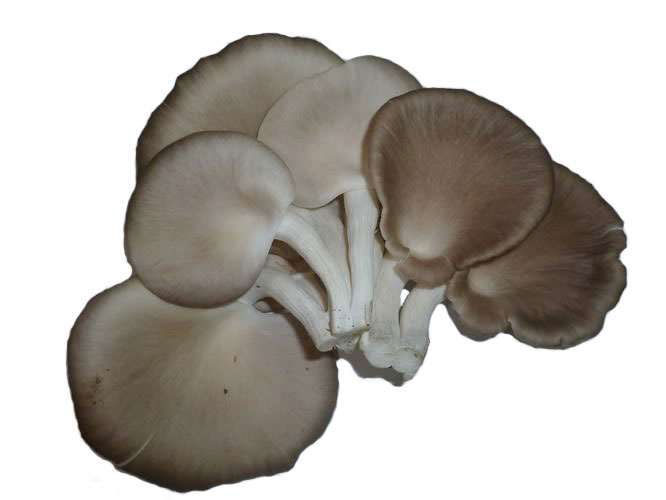
Abalone, Black
Black Abalone mushrooms are medium to large in size and are irregular in shape with a flat, fan-like cap with curved and ripled edges. The surface of the cap is smooth, silky, plump, and firm with light brown hues and dark brown trim. On the underside, there are many cream-colored gills that are soft and spongy. When cooked, Black Abalone mushrooms are velvety, meaty, and crunchy with an earthy, buttery flavor.
Black Abalone mushrooms are rich in niacin which helps keep the skin, hair, eyes, and liver healthy, and pantothenic acid which is used in energy production and fat metabolism in the human body.
ABALONE, BLACK
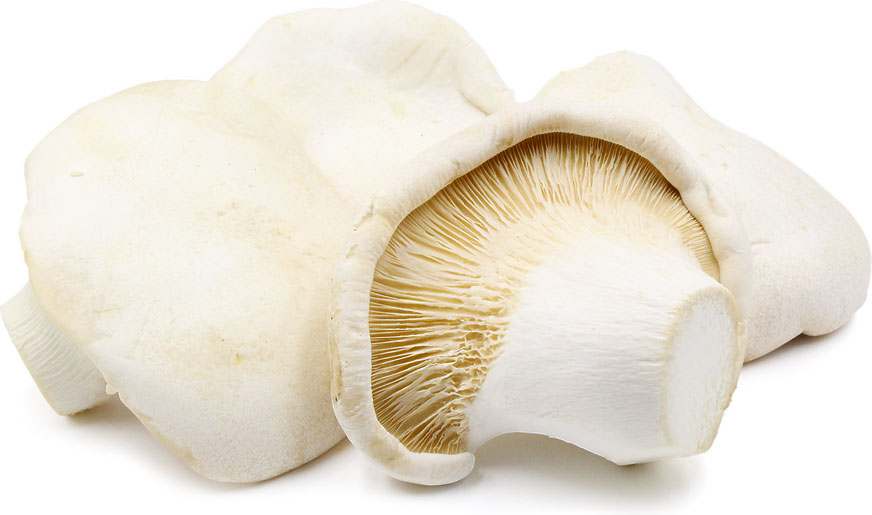
Abalone, White
White Abalone mushrooms are medium to large in size and are irregular and oblong with a vase-like shape averaging 5 to 25 centimeters in diameter. The skin is ivory to white and is smooth, silky, plump, and firm with small golden lines and perforations found throughout the surface with many gills under the cap. The cream-colored flesh is crisp, dense, and spongy with a meaty texture. When cooked, Abalone mushrooms are slippery and velvety with an earthy, buttery flavor with notes of pepper. They are commonly used as a meat substitute in vegetarian dishes and are favored for their substantial texture and buttery, rich flavor.
Abalone mushrooms are a good source of dietary fiber, iron, phosphorus, and some antioxidants.
ABALONE, WHITE

Beech, Brown
(aka Clamshell, Hon Shimeji)
These fairytale mushrooms have a rich savory, nutty flavor and crunchy texture. Some of the tastiest around, Brown Beech mushrooms are small to medium in size, growing in tightly-packed bunches with convex, rounded, button caps and slender stems. The petite caps are buff to burlap-colored, smooth, and crisp. The ivory to cream-colored stems are slender, averaging 5 to 7 centimeters in height, and connect to a thick, white, porous inedible base. Brown Beech mushrooms have piquant, savory aromas and a sharp, bitter flavor when fresh. When cooked, the texture is tender and chewy with a mild, herbal, and nutty flavor.
Brown Beech mushrooms contain iron, zinc, copper, potassium, thiamine, pantothenic acid, and riboflavin.
Beech, Brown
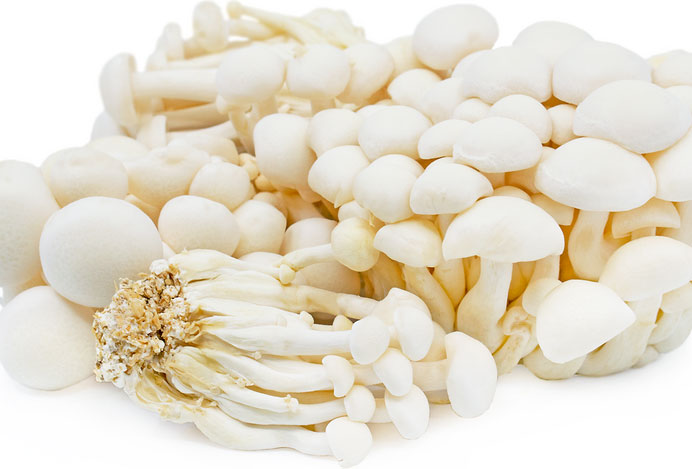
Beech, White
(aka White Hon Shimeji, Alba Clamshell, White Clamshell)
Hon Shimeji mushrooms are small to medium in size, growing in tightly-packed bunches with convex, rounded, button caps and slender stems. The petite caps are pure white, pale, smooth, and crisp. The ivory stems are slender, averaging 5 to 7 centimeters in height, and connect to a thick, white, inedible base. White Beech mushrooms have an almond-like aroma and a sharp, bitter flavor when fresh. When cooked, the texture is crunchy with a buttery and nutty shellfish flavor.
White Hon Shimeji mushrooms contain iron, zinc, copper, potassium, thiamine, pantothenic acid, and riboflavin.
Beech, White
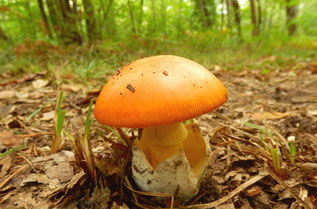
Caesar’s
(aka Amanita caesarea)
According to a legend, only the Roman emperor was allowed to eat this delicious treat. Caesar’s mushrooms are medium to large in size and are egg-shaped when young, expanding out to a thick cylindrical stem with a rounded, convex cap averaging 6 to 15 centimeters in diameter when mature. The smooth, free of warts, deep orange-red cap is firm and somewhat elastic, holding its shape when cut and has light striations around the edges. When the cap is fully expanded, there may be some slight tears and splits due to moisture loss. The underbelly of the cap is lined with pale yellow gills that are free and not attached to the stem. The stipe or stem averages 8 to 15 centimeters in length, 2 to 4 centimeters in diameter, and is yellow-ivory with a piece of tissue known as a volva surrounding the bottom of the stem. Caesar’s mushrooms are tender, fragrant, and mild in flavor with notes of hazelnuts and chestnuts.
Caesar’s mushrooms contain copper, zinc, B vitamins, fiber, magnesium, and some potassium.
Caesar’s
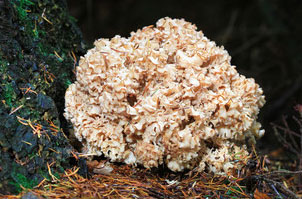
Cauliflower
(aka Noodle, Wood Cauliflower, Rooting Cauliflower)
Cauliflower mushrooms are cap-less fungi composed of clusters of frilled, leaf-like branches emerging from a joined base. The mushrooms widely vary in size, averaging 10 to 30 centimeters in diameter, and can be found in many different contorted shapes. The folded, flexible surface ranges in color from ivory, pale yellow, to white, depending on maturity and is smooth and waxy with small pores on one side that release spores. Cauliflower mushrooms have a brittle, semi-firm, and chewy consistency with a strong aroma of musk and earth. When cooked, they have a neutral, earthy, and subtly nutty flavor with notes of fennel and almond.
Cauliflower mushrooms contain sparassol, a nutrient that is known to have antifungal and antibiotic properties. The mushrooms also contain beta-glucans, which are a type of dietary fiber that is believed to help boost immunity, heart health, and reduce cholesterol.
Cauliflower
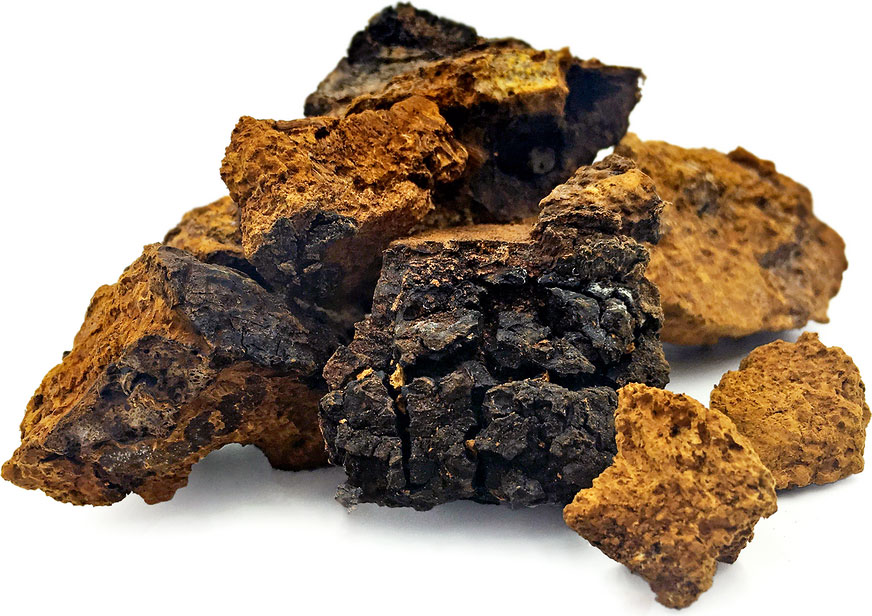
Chaga
(aka Black Mass, Clinker Polypore, Birch Canker Polypore, Cinder Conk)
Chaga mushrooms are medium to large in size, averaging 25 to 40 centimeters in diameter, and are an irregularly-shaped, dense woody growth resembling the appearance of burnt coal. The conk is composed of a gnarled, sooty black exterior called the sclerotium and a softer golden brown, cork-like interior. Chaga mushrooms have little aroma when raw, but when cooked, they release notes of slightly sweet, dark cocoa, tobacco, and vanilla and have a mild, earthy flavor.
Chaga mushrooms contain many nutrients, including calcium, iron, zinc, B-complex vitamins, vitamin D, copper, manganese, potassium, amino acids, fiber, and magnesium. These vitamins and minerals contain anti-aging properties and can help reduce symptoms of cholesterol and blood pressure, improve immune system health, and reduce inflammation.
Chaga
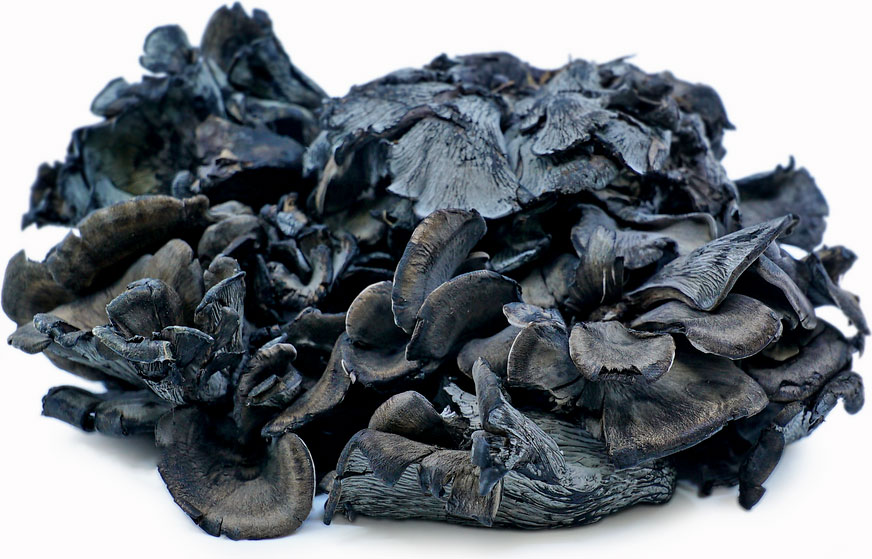
Chanterelle, Blue
(aka Polyozellus multiplex)
These are a favorite because of their availability and unique delightfully sweet, yet slightly fruity aroma that’s reminiscent of apricots. Their flavor is much more complex compared to most other mushrooms “with an aroma that’s a cross between the rose notes of black pepper and stone fruit.” Chanterelle mushrooms are small to medium in size with the ability to weigh up to two pounds and are convex in shape with a wavy cap connecting to a dense stem. The cap is smooth, delicate, and gold-orange with irregular, uneven edges that are thick, blunt, and taper down. Underneath the cap, the gills have forked ridges with blunt edges, and these ridges run down the matching gold-orange firm, thick, and solid stem. When snapped in half, the flesh of the mushroom will be pale white and have a fruity aroma with notes of apricot and peach. When cooked, Chanterelle mushrooms are chewy with a velvety consistency and have a woodsy, earthy flavor with hints of mild pepper.
A study published in 2014 showed that compounds extracted from the Blue Chanterelle mushroom contain anti-angiogenesis compounds. These compounds are used to treat cancer. Researchers have also found anti-viral compounds in Blue Chanterelle mushrooms that could be beneficial to people with diabetes because they inhibit glucosidase. This helps slow down the processing of complex carbohydrates in those suffering from diabetes.
Chanterelle, Blue
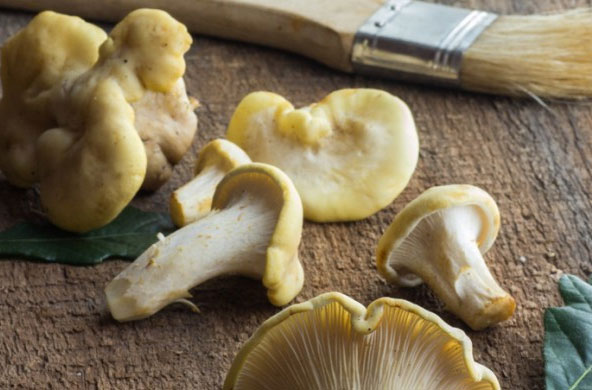
Chanterelle, White
(aka White Back)
These are a favorite because of their availability and unique delightfully sweet, yet slightly fruity aroma that’s reminiscent of apricots. Their flavor is much more complex compared to most other mushrooms “with an aroma that’s a cross between the rose notes of black pepper and stone fruit.” Chanterelle mushrooms are small to medium in size with the ability to weigh up to two pounds and are convex in shape with a wavy cap connecting to a dense stem. The cap is smooth, delicate, and gold-orange with irregular, uneven edges that are thick, blunt, and taper down. Underneath the cap, the gills have forked ridges with blunt edges, and these ridges run down the matching gold-orange firm, thick, and solid stem. When snapped in half, the flesh of the mushroom will be pale white and have a fruity aroma with notes of apricot and peach. When cooked, Chanterelle mushrooms are chewy with a velvety consistency and have a woodsy, earthy flavor with hints of mild pepper.
White chanterelle mushrooms contain vitamin A, potassium, iron, and essential amino acids.
Chanterelle, White
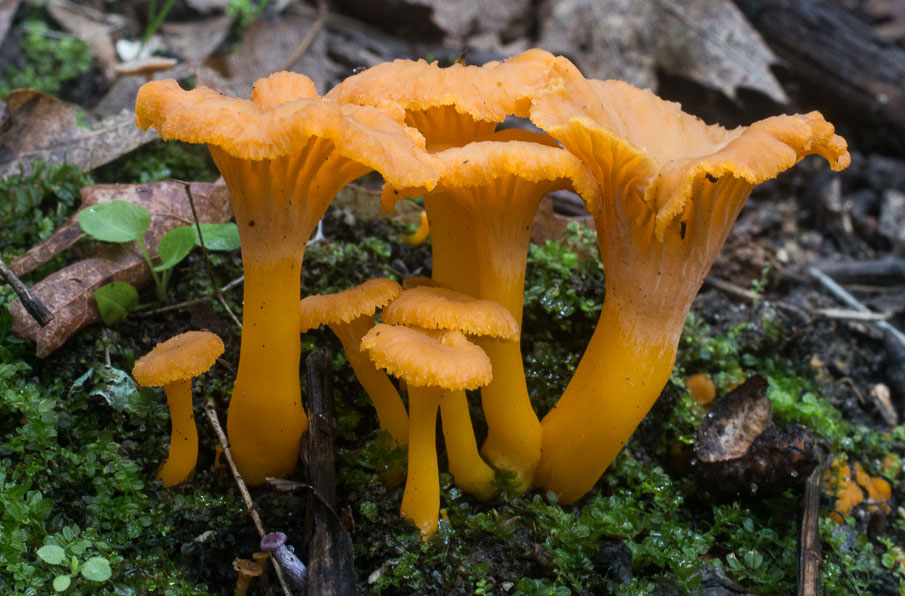
Chanterelle, Yellow Foot
(aka Winter, Funnel Chanterelle)
Their flavor is much more complex compared to most other mushrooms “with an aroma that’s a cross between the rose notes of black pepper and stone fruit.” Chanterelle mushrooms are small to medium in size with the ability to weigh up to two pounds and are convex in shape with a wavy cap connecting to a dense stem. The cap is smooth, delicate, and gold-orange with irregular, uneven edges that are thick, blunt, and taper down. Underneath the cap, the gills have forked ridges with blunt edges, and these ridges run down the matching gold-orange, firm, thick, and solid stem. When snapped in half, the flesh of the mushroom will be pale white and have a fruity aroma with notes of apricot and peach. When cooked, Chanterelle mushrooms are chewy with a velvety consistency and have a woodsy, earthy flavor with hints of mild pepper.
These Chanterelle mushrooms contain fiber, vitamins B, D, and K, and copper.
Chanterelle, Yellow Foot
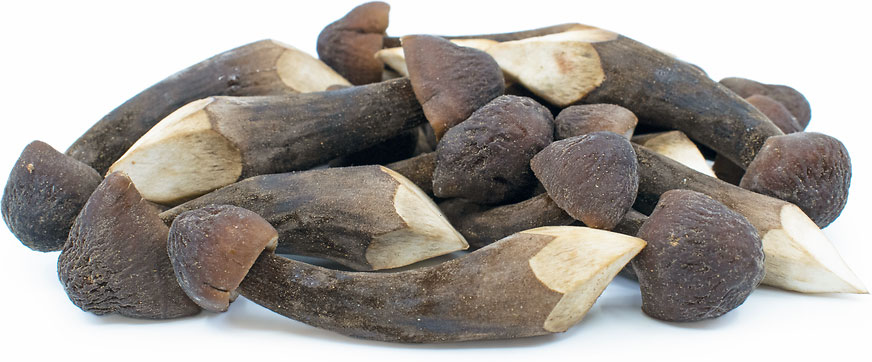
Chestnut Royale
(aka Beech Root Mushroom)
Chestnut Royale mushrooms are small to medium in size, grown as a single stem or in small groups, and have a convex cap that is attached to a thick, dense stem. The brown to grey-brown cap can grow 2 to 15 centimeters in diameter and is smooth, velvety, and slightly slimy when wet and young. As the mushroom ages, it will dry and become wrinkled. The gills underneath the cap are bright white to cream-colored and are evenly spaced, connecting to the central, brown stem that narrows near the cap and averages 5 to 10 centimeters in length. Chestnut Royale mushrooms have a clean, woodsy aroma, a meaty texture, and when cooked, they have a rich, nutty, and mildly sweet flavor.
Chestnut Royale mushrooms contain selenium, copper, potassium, riboflavin, niacin, and vitamin D.
Chestnut Royale
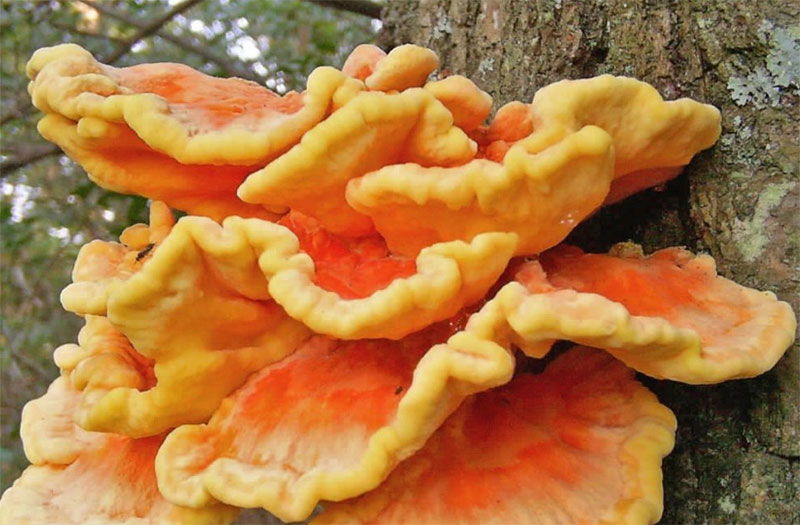
Chicken of the Woods
(aka Sulphur Shelf)
A highly versatile mushroom, it has a similar texture and taste to chicken. Chicken of the Woods mushrooms are medium to large in size, averaging 5 to 25 centimeters in diameter and are broad, fan-shaped, and grow in multiple, overlapping brackets that look like miniature shelves on the sides of trees. The caps are smooth or slightly wrinkled and are bright orange and white when young, fading to a dull orange and then to completely white when mature. The cap is also slightly grooved with a suede-like feel and a rounded edge. Instead of gills, the underside is composed of white to sulfur-colored, tightly packed pores from which spores can be released. When cooked, Chicken of the Woods mushrooms are juicy, succulent, and meaty with a mild, lemony flavor that many compare to the taste of chicken, lobster, or crab.
Chicken of the Woods mushrooms contain potassium, vitamin C, fiber, vitamin A, and are believed to have antifungal and antibiotic properties.
Chicken of the Woods
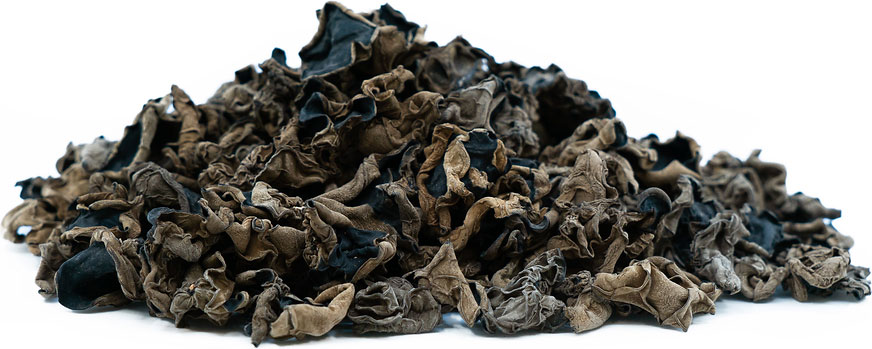
Cloud Ear
(aka Black Fungus)
Dried Cloud Ear mushrooms widely vary in size and appearance, depending on if they were kept whole or broken into smaller pieces before dehydrating. The mushrooms have a condensed, wrinkled, and creased cup-like nature with curled edges and are generally delicate and brittle, crumbling when pressure is applied. Dried Cloud Ear mushrooms will also range in color from white, ivory, light brown, to dark brown, as the fungus typically matches the color of its host tree. Dried Cloud Ear mushrooms emit a robust, pungent aroma that some say is reminiscent of the smell of black vinegar and dark soy sauce with earthy, umami notes. When rehydrated, the mushrooms will expand in size and develop a slippery, elastic, and crisp, snap-like consistency. Cloud Ear mushrooms have a very mild, subtly musty, sweet, and faintly bitter flavor and are mainly used for their firm, chewy texture in dishes rather than for their taste.
Cloud Ear mushrooms are a source of antioxidants to reduce inflammation, strengthen the immune system, and protect cells against free radical damage. The mushrooms also provide fiber to regulate the digestive tract, magnesium to regulate nerve function, iron to develop the protein hemoglobin for oxygen transport through the bloodstream, and lower amounts of zinc, copper, B vitamins, and selenium.
Cloud Ear
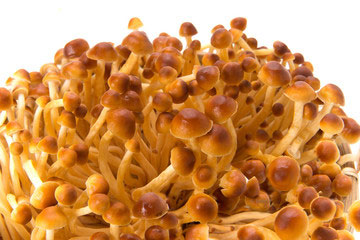
Enoki, Golden
Golden Enoki mushrooms combine the best of both worlds because they have the Enokitake’s lovely, elegant shape and the color and flavor of the richer mushroom varieties. Golden brown caps rest atop tan stems, and their flavor is yeasty and more pronounced than that of their pigment-free cousin. Their stems can grow up to 12 centimeters in length. They keep their color once cooked and are wonderful in salads, sushi, and sandwiches.
Enoki mushrooms contain copper, vitamin B6, potassium, magnesium, calcium, iron, dietary fiber, and zinc. They are also known to have anti-inflammatory properties and are excellent immune system boosters.
Enoki, Golden

Enokitake
(aka Enoki, Golden Needle, Lily, Velvet Foot)
Enoki mushrooms are very small in size and grow in bouquets of tightly-packed, long stems topped with petite, convex caps. The snow-white caps are tender, smooth, delicate, and are connected to matching white stems that are thin and can grow up to 12 centimeters in length. Enoki mushrooms are crisp and firm with a crunchy bite and a mild, fruity flavor. Wild Enoki mushrooms are significantly different in appearance from the cultivated form as they have larger caps, shorter stems, range in color from orange to brown, are slightly sticky and rubbery, are velvety in consistency, and have an earthier flavor.
Enoki mushrooms contain copper, vitamin B6, potassium, magnesium, calcium, iron, dietary fiber, and zinc. They are also known to have anti-inflammatory properties and are excellent immune system boosters.
Enokitake
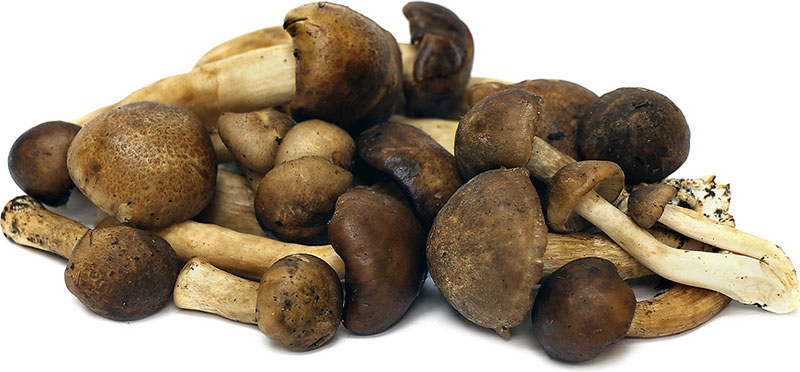
Fried Chicken
(aka Clustered Domecap)
Fried Chicken mushrooms are small to medium in size, averaging 3 to 12 centimeters in diameter, and are convex in shape, growing in dense clusters. The dome-shaped caps range in color from light beige, dark brown, to gray and are smooth and moist with scalloped edges. When mature, the caps begin to turn upward at the margin, revealing the tightly-packed white gills beneath the cap. The grey-brown stems can grow 5 to 10 centimeters in length and are thick, fibrous, and firm. When cooked, Fried Chicken mushrooms have a sweet aroma, a chewy, meat-like texture, and a rich, nutty, and mild flavor.
Fried Chicken mushrooms have anti-inflammatory properties and contain vitamins B, D, and K, copper, and fiber.
Fried Chicken
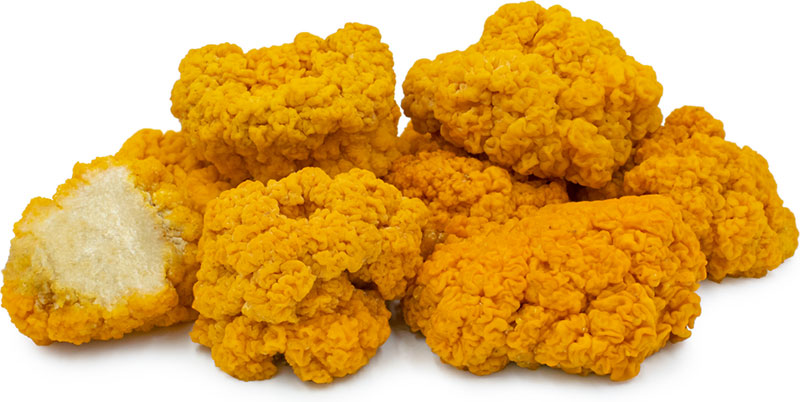
Golden Ear
(aka Witch’s Butter, Yellow Ear, Yellow Brain Fungus)
Golden Ear mushrooms are small to medium in size, averaging 5 to 10 centimeters in diameter, and are stemless and composed of clusters of many wrinkled, folded lobes. When fresh, the bright orange to yellow flesh appears wet and has a gelatinous to an opaque appearance with a white, milky center. When dried, the flesh becomes shriveled and takes on a golden matte finish that becomes brittle and similar in appearance to an orange cauliflower. When cooked, Golden Ear mushrooms are slightly rubbery with a mild, neutral flavor.
Golden Ear mushrooms are a good source of potassium, iron, and calcium. They are also a source of trace elements such as manganese, a beneficial antioxidant that has a role in the production of collagen to help prevent and repair wrinkles.
Golden Ear
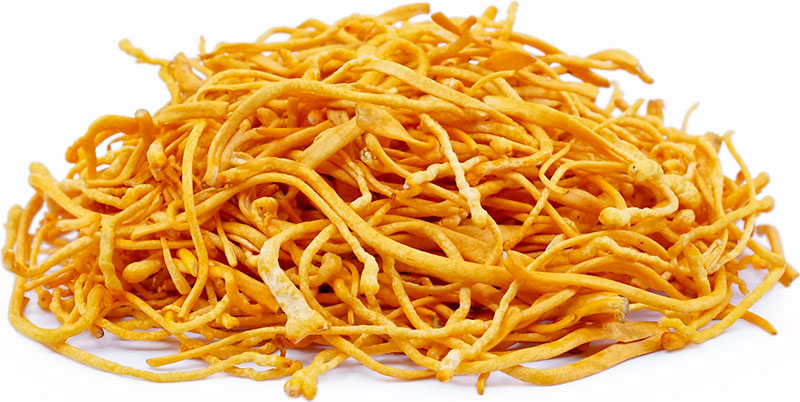
Golden Thread
(aka Caterpillar Mushroom)
Golden Thread mushrooms are very small in size, averaging 2 to 8 centimeters in length, and are slender, thin, and elongated in shape. Each mushroom has a curved profile, a yellow-orange hue with a light, bumpy texture, and a club-like cap that appears as a bulbous, rounded end on a thin stem. Inside the mushroom, the flesh is pale orange to white and is spongy and soft. When consumed, Golden Thread mushrooms are tender with a musky aroma and a mild, earthy, and slightly sweet flavor.
Golden Thread mushrooms contain vitamins D and K, essential amino acids, and immune supporting polysaccharides and beta-glucans.
Golden Thread
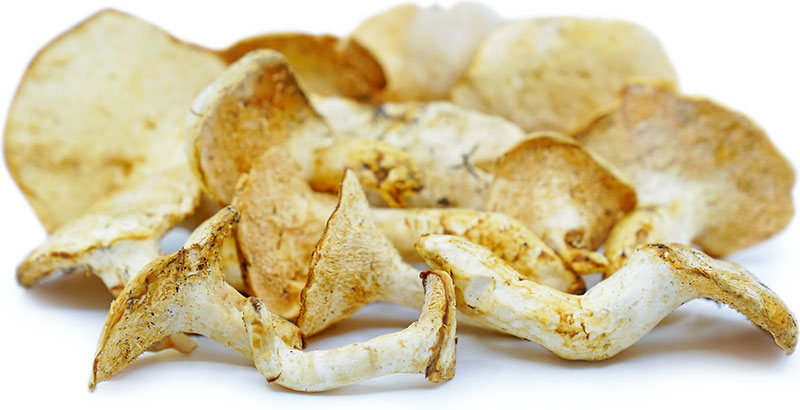
Hedgehog
(aka Sweet Tooth, Pig’s Trotter, Wood Urchin)
Hedgehog mushrooms are small to large in size, averaging 5 to 17 centimeters in diameter, and are irregular in shape with a flattened, depressed cap and a thin, off-centered stem. The smooth cap can be convex or upturned, is dry, thick, and firm, and ranges in color from yellow, buff, to orange. The cap also has wavy margins and when mature, the edges may crack. Underneath the cap, there are many cream-colored teeth or spore-bearing spines that hang down instead of gills. The stems are also white, orange, or buff, average 3 to 10 centimeters in length, and depending on the variety may be hollow in the center. When cooked, Hedgehog mushrooms have a fruity aroma and a chewy texture with an earthy, nutty, peppery, and smoky flavor.
Hedgehog mushrooms contain vitamin D, potassium, iron, and anti-inflammatory and antibacterial properties.
Hedgehog
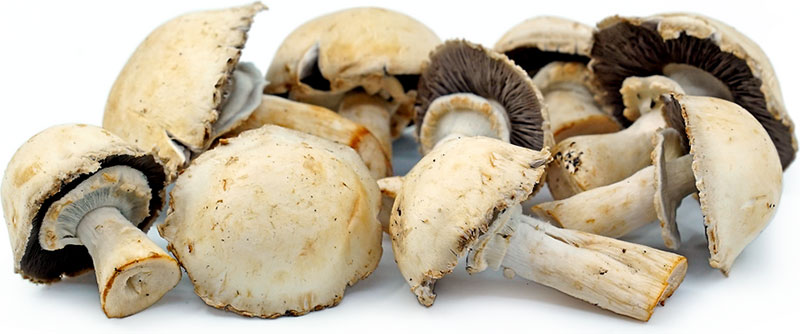
Horse
(aka Almond, Snowball)
Horse mushrooms are medium to large in size, averaging 10 to 25 centimeters in diameter, and are rounded when young and flatten out when mature. The creamy white cap is smooth, firm, thick, and dry, and as it ages some light brown scales may appear in the center. Underneath the cap, the gills are free and crowded, first appearing light pink and then transforming into a dark brown, continuing to darken over time. When the mushroom is young, there is a distinct cogwheel pattern on the unopened veil, and as it matures, the veil runs down the stout stem and forms a small skirt. The stem can grow 4 to 10 centimeters in height and is thin, becoming hollow with age. If bruised or exposed to air, the cap of the Horse mushroom may sometimes turn yellow. The smell of the Horse mushroom is said to be distinct, with a pungent anise or licorice aroma. When cooked, Horse mushrooms are succulent and crisp with a sweet, mild almond flavor.
Horse mushrooms contain high amounts of vitamin D. They also contain some iron, copper, zinc, and potassium.
Horse
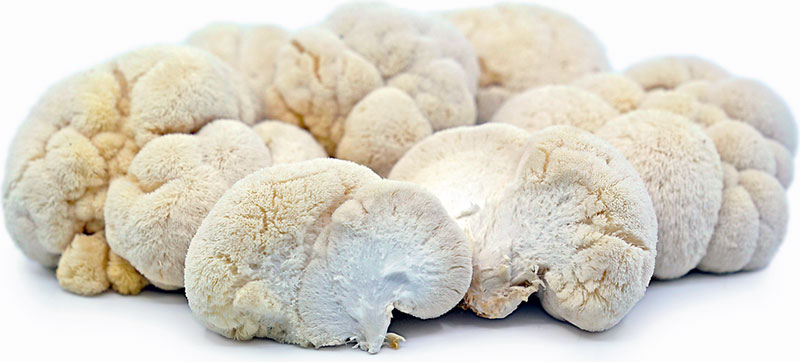
Lion’s Mane
(aka Yamabushitake, Bearded Tooth, Monkey Head)
Lion’s Mane mushrooms are medium to large in size, averaging 10 to 25 centimeters in diameter, and are spherical and elongated with a single, hidden base. The tough, fibrous base is covered in soft, overlapping, slender spines that average 1 to 5 centimeters in length and dangle freely down towards the ground, ending in pointed tips. Each of the spines, also called teeth, release spores into the air, promoting new growth on nearby trees. When the mushroom is young, the spines are bright white, but with age, the spines discolor to pale brown-yellow. Lion’s Mane mushrooms are tender and chewy with a mild, sweet, seafood flavor reminiscent of scallops lobster, or crab.
This species contains a high amount of potassium and iron and contains carbohydrates, protein, and fiber. Modern scientific tests have revealed that Lion’s Mane offers a number of nootropic (mind-affecting) benefits, boosting cognitive function and helping to enhance memory. It’s considered the world’s first “smart mushroom,” with proven improvements in cognitive function and nerve regeneration, which could potentially benefit those suffering from dementia, multiple sclerosis, Parkinson’s, peripheral neuropathy, seizures, anxiety, depression, and muscle cramps and spasms. Lion’s Mane has other medical benefits as well, including improved digestion, a strengthened immune system, and an improved lipid profile.
Lion’s Mane
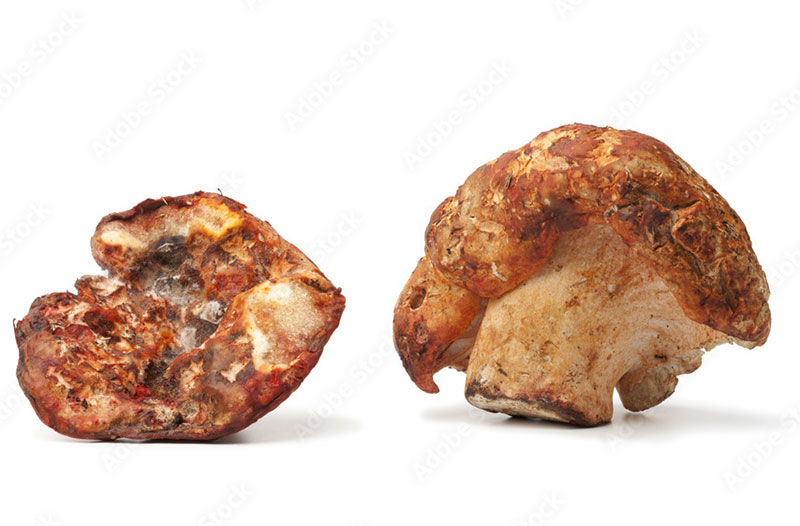
Lobster
Contrary to its name, it is not a mushroom but rather a parasitic ascomycete fungus. An unusual species, the parasite has to start with a Russula brevipes (Russula mushrooms) or a Lactarius piperatus to be cultivated. In taking over the mushroom, the parasite stops the mushroom from producing gills and causes the mushroom to grow small sacks that contain spores for the parasite. They are gnarled, contorted fungi, averaging 15 to 20 centimeters in diameter, and have an irregular shape with little to no stem and a cracked cap. The surface of the cap is textured, firm, and mottled, ranging in color from white to a vibrant orange-red, with split, wavy edges. Underneath the cap, the gills of the host mushroom almost disappear under the parasitic fungus, leaving the area somewhat rippled and disfigured. When sliced, the flesh is white, dense, and spongy with a faint, seafood-like aroma. Lobster mushrooms have a chewy texture with a subtle nutty, woody, and delicate flavor.
Lobster mushrooms contain iron, calcium, dietary fiber, protein, and vitamins A, B-complex, and C.
Lobster
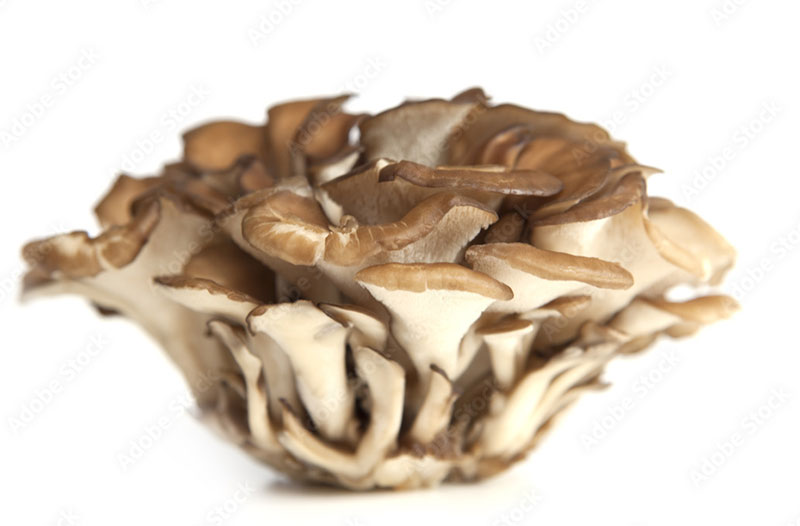
Maitake
(aka Hen of the Woods, Ram’s Head, Sheep’s Head)
Maitake mushrooms are comprised of a fruiting body and a single branched stem with many tightly-packed layers of curved, smooth caps. When the mushrooms are dried, they are generally broken into smaller pieces and are naturally dehydrated, creating delicate clusters of slender, flat, and shriveled caps. Dried Maitake mushrooms are semi-rough, brittle, and crisp, appearing in shades of brown, tan, ivory, to cream. The variety does not exhibit gills and instead is pocked with tiny pores on the underside of the caps. When reconstituted, dried Maitake mushrooms develop a chewy, slightly firm, meat-like texture and contain smokey, earthy, and umami-filled flavors with nuances of warm spices such as clove, ginger, and cinnamon.
Maitake mushrooms are an excellent source of potassium to balance fluid levels within the body, fiber to regulate the digestive tract, and copper to maintain optimal metabolism. The mushrooms are also a good source of vitamin D, niacin, antioxidants, and beta-glucans, which are a type of soluble fiber that is believed to help the immune system fight off bacteria. In traditional medicines of Japan, Maitake mushrooms are commonly steeped into a tea, taken in capsule form, or made into a tonic to strengthen the immune system and lower blood pressure.
Maitake
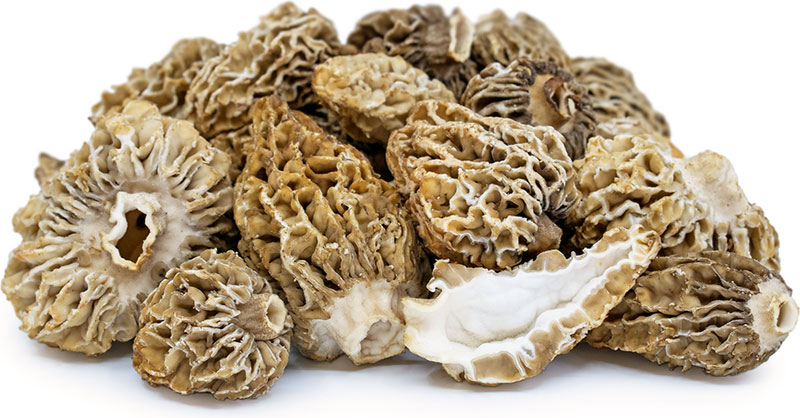
Morel
(aka Blushing, Purple, White, Yellow, Common)
Morel mushrooms are small to large in size with caps that are oblong, cone-shaped, bulbous, or egg-shaped and are attached to short, stout stems. The cap averages 2 to 7 centimeters in diameter and ranges in color from blonde, light brown, grey, to dark brown. The fragile, brittle cap also has a hollow, honeycomb-like exterior that consists of many irregular holes and ridges with a small, bumpy texture and attaches directly to the stem. Inside the cap and stem, there is a hollow cavity running the length of the mushroom, and the stem is white and averages 2 to 9 centimeters in length. When cooked, Morel mushrooms are meaty and tender with a deep, earthy, nutty, and woodsy flavor with ridges that hold on to any incredible sauce.
Morel mushrooms are an excellent source of fiber, iron, and manganese, and also contain copper, phosphorus, zinc, vitamins D, E, K, and B, potassium, and calcium.
Morel
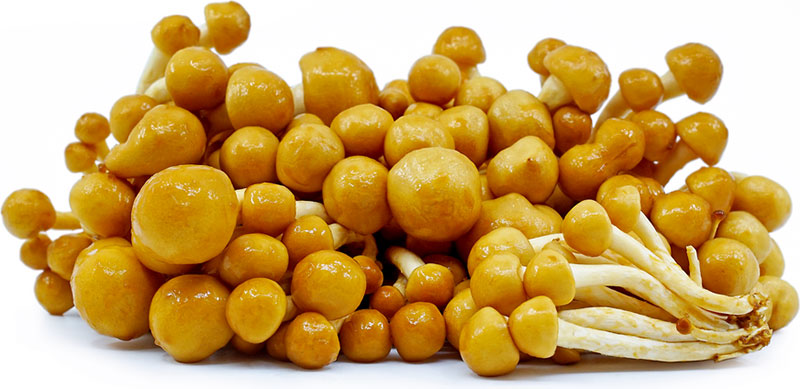
Nameko
(aka Forest Nameko, Butterscotch)
Nameko mushrooms are small to medium in size with caps averaging 2 to 5 centimeters in diameter and slender, straight stems. The smooth, rounded caps are orange to amber with a glossy sheen caused by a natural layer of gelatin coating the surface. With age, the caps will slowly flatten and flare at the edges. Underneath the cap, there are many light yellow to white gills. The stem is tan, 5 to 7 centimeters in length, flexible, and thin. When cooked, Nameko mushrooms are firm and silky with a cashew-butterscotch aroma and a mild fruity, nutty, and earthy flavor.
Nameko mushrooms are a good source of vitamins, including thiamine, riboflavin, and niacin, and minerals,
including calcium, potassium, and sodium.
Nameko
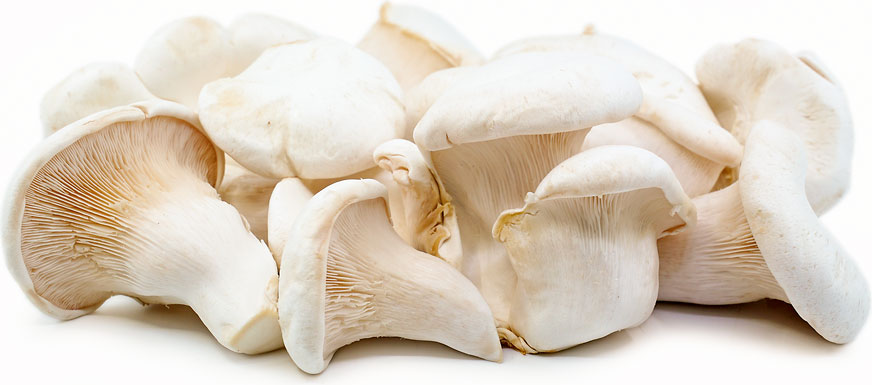
Nebrodini Bianco
(aka Sicilian Grilling Oysters, Nebrodi)
Nebrodini Bianco mushrooms have a large, vase-like shape, averaging 7 to 10 centimeters in length and 5 to 20 centimeters in diameter, and have a flattened cap with a cylindrical, thick stem. The caps are smooth and firm, ranging in color from white to ivory, and have curled edges. Underneath the cap, prominent and angled ivory gills connect the stem and cap, and the flesh is spongy, dense, and cream-colored. These mushrooms have a tender and velvety consistency with a sweet, mild, peppery, and earthy flavor reminiscent of scallops or abalone.
Nebrodini Bianco mushrooms are an excellent source of zinc and iron, which can help boost the immune system and regulate bodily functions. The mushrooms are also a good source of manganese, calcium, and vitamin D, which is a vitamin that can help strengthen bones and is difficult to find naturally in food sources.
Nebrodini Bianco
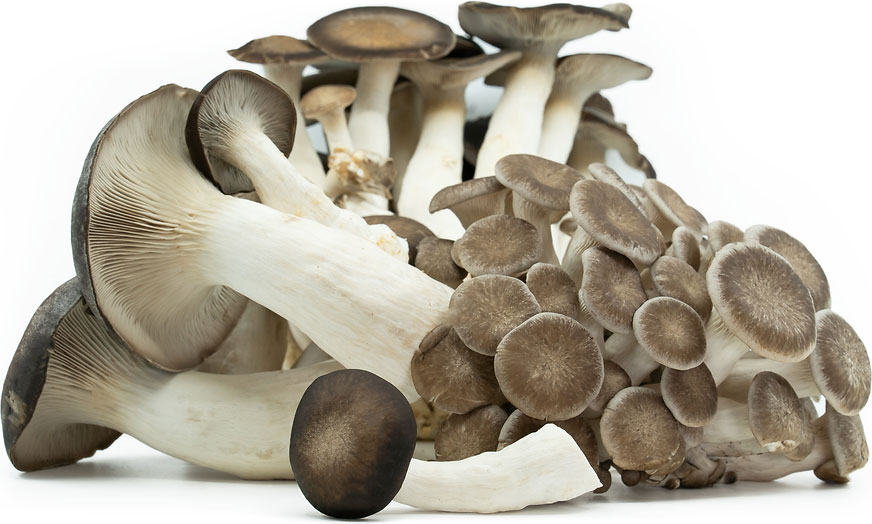
Oyster, Black Pearl
Black Oyster mushrooms are a medium to large oyster variety growing in shelf-like structures, with caps averaging 5 to 25 centimeters in diameter and a very short or non-existent stem. The caps, when young, may appear smaller and more convex, growing larger, flatter, broader, and wavier over time. The caps also display a unique black and white marbling across the surface, and there are white gills underneath, giving the mushrooms a meaty and firm consistency. The thick white stems are also edible. Black Pearl Oyster mushrooms have a slightly chewy texture and are soft with a bittersweet aroma reminiscent of anise. They also have a mild, sweet, and nutty, umami-forward flavor.
Black Pearl Oyster mushrooms are a source of calcium, iron, and some potassium, and vitamins C, B, and D.
Oyster, Black Pearl
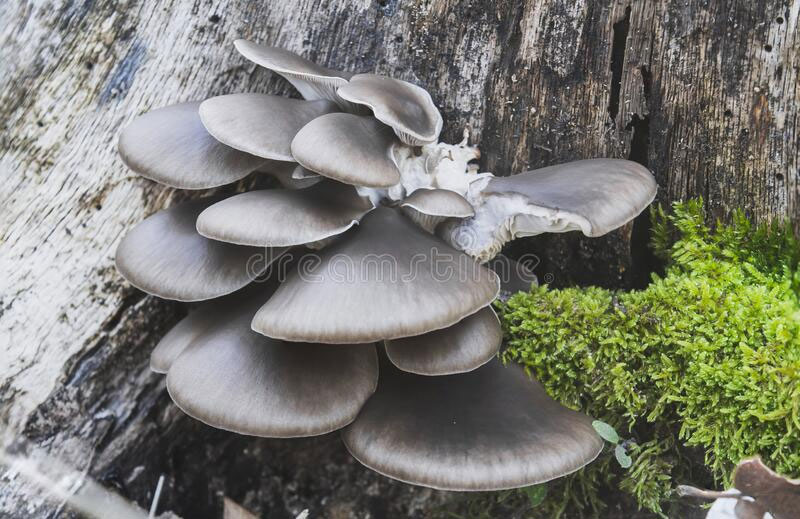
Oyster, Blue
Blue Oyster mushrooms grow in large, shelf-life structures comprised of dense, overlapping clusters of individual fungi. The size and shape of the mushrooms will widely vary, depending on growing conditions. Blue Oyster mushrooms can have short, tapered stems with a flat, convex cap, averaging 2 to 30 centimeters in diameter, or the stems can be elongated with smaller caps. The surface of the mushroom’s cap is smooth, taut, and brittle, sometimes containing a slight depression in the center and displaying wavy edges. The caps also appear dark blue when young, lightening into a blue-grey shade with maturity. Underneath the cap, there are slender and vertical white gills that extend down the stem. Blue Oyster mushrooms have a spongy, dense, and slightly chewy consistency. When raw, the mushrooms bear a scent reminiscent of the seashore combined with anise and have a subtly metallic flavor. Once cooked, Blue Oyster mushrooms soften, developing a velvety, tender texture and contain a mild, earthy, and savory taste with licorice-like nuances.
Blue Oyster mushrooms are a good source of vitamin D, as well as a source of B vitamins, potassium, vitamin A, and other amounts of iron, copper, and riboflavin. In addition to vitamins and minerals, Blue Oyster mushrooms contain chitin, a polymer that promotes healthy digestive bacteria and antioxidant properties to reduce
oxidative stress.
Oyster, Blue
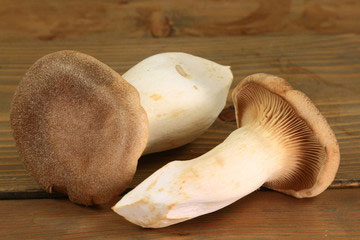
Oyster, King Trumpet
King Trumpet Oyster mushrooms are medium to large in size and are easily identified by their thick cylindrical stems and their small, flattened caps. The ivory to white stems can grow up to 20 centimeters in length, 5 centimeters in diameter, and are firm, dense, and chewy. The small, smooth caps are grey to brown and have rounded, curved edges. Underneath the cap, the stem and cap are joined by off-white, thin, short gills. Raw King Trumpets, though dense and spongy in texture, lack aroma and flavor, but when cooked, the mushrooms have a savory umami flavor, a soft, crunchy texture, and a mild flavor reminiscent of abalone.
King Trumpet mushrooms contain riboflavin, vitamins B6, C, and D, niacin, potassium, fiber, and folate. They also contain high amounts of a naturally-occurring amino acid, ergothioneine, which is an antioxidant. This particular antioxidant is stored in organs like the liver and kidneys and helps reduce the risk of chronic disease.
Oyster, King Trumpet
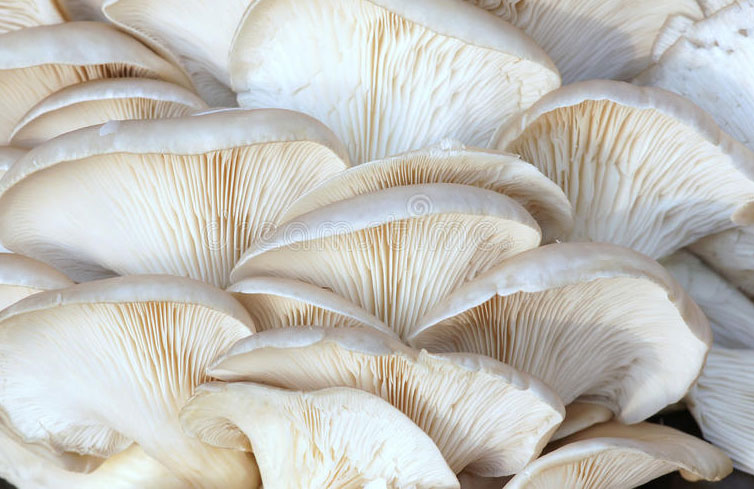
Oyster, Phoenix Tail
Phoenix Tail Oyster mushrooms are medium to large in size with caps averaging 5 to 20 centimeters in diameter and are found in shelf-like clusters of five to six mushrooms. The smooth, thick caps are semi-circular or fan-shaped and range in color from white-beige to pale tan with lilac or gray tones. The cap is also finely lined and has wavy and undulating edges when mature. Underneath the cap, there are many soft, short, white gills closely aligned to one another, and the short, ivory stem averages 1 to 7 centimeters in length. Phoenix Tail Oyster mushrooms have a distinct aroma with seafood undertones and are velvety and tender with a mild, faintly sweet flavor.
Phoenix Tail Oyster mushrooms contain amino acids such as thiamine, riboflavin, folic acid, sterols, and carotenoids. They also contain vitamin C, potassium, and iron.
Oyster, Phoenix Tail
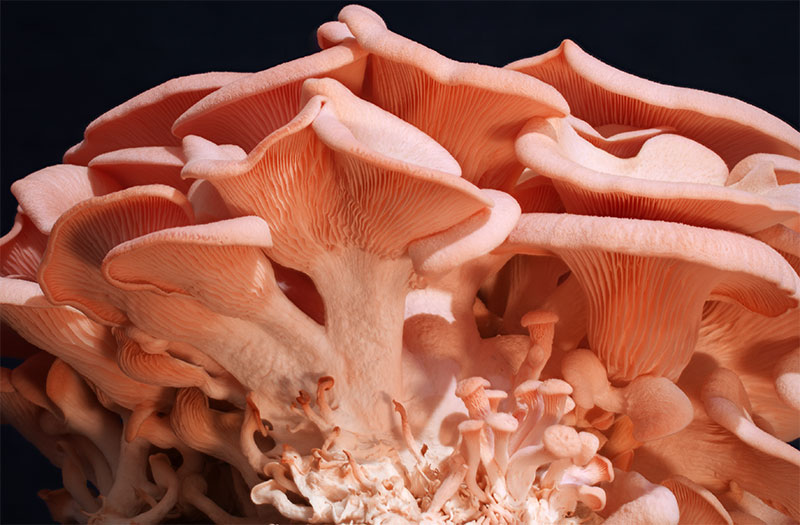
Oyster, Pink Flamingo
Pink Flamingo Oyster mushrooms are small to medium in size with caps averaging 2 to 5 centimeters in diameter and are attached to short or non-existent stems, growing in layered clusters. The thin caps are smooth, finely lined, and are intensely pink when raw, changing to an orange-brown when cooked. The edges of the cap also begin flat and curl with age, almost curling into a tube shape. Underneath the cap, there are many soft, short, deep pink gills that connect down into a very short stem. Pink Flamingo Oyster mushrooms are meaty and chewy in texture, despite their thin flesh, and have a pungent, seafood-like aroma. When raw, these mushrooms have a sour taste, but when cooked, they develop a mild, woody flavor that readily takes on the flavors of accompanying ingredients.
Pink Flamingo Oyster mushrooms contain fiber, potassium, copper, riboflavin, vitamin B6, folate, and ergothioneine, which is an antioxidant that may reduce instances of cardiovascular disease by helping to prevent plaque build-up in the arteries.
Oyster, Pink Flamingo
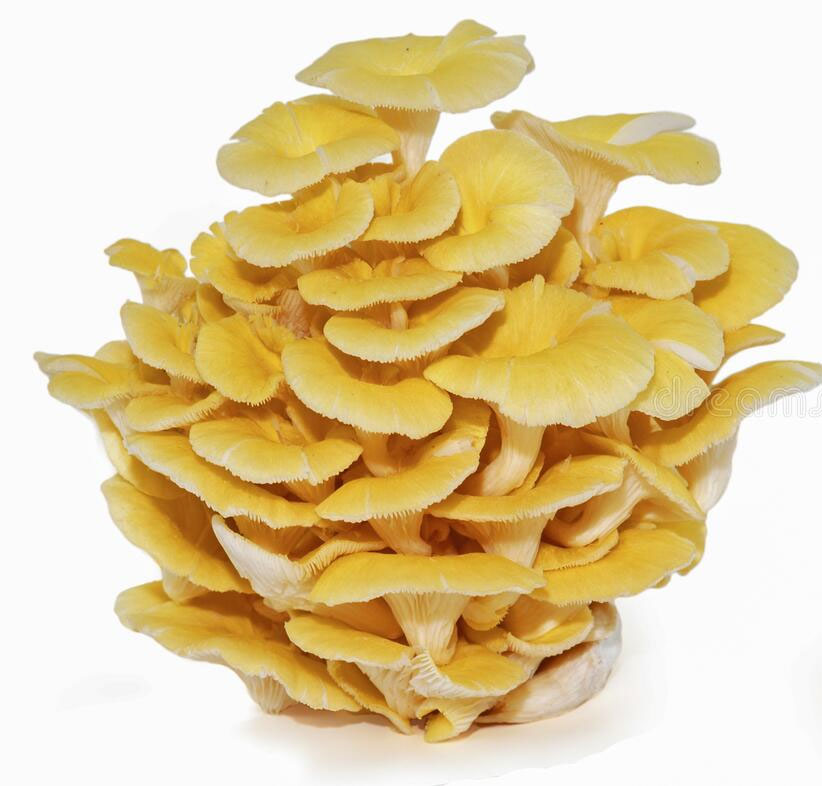
Oyster, Yellow
Yellow oyster mushrooms are small to medium in size with caps averaging 2 to 6 centimeters in diameter and are attached to a short or nonexistent stem. The thin, dry, smooth caps are daffodil yellow, semi-circular, and look like small petals clustered and layered into a small bouquet. When young, the caps are flat, and with age, they begin to curl and become convex with wavy edges. Underneath the caps, there are many soft, short, white gills that connect to an ivory white, small stem. Yellow Oyster mushrooms have a fruity aroma reminiscent of an aged red wine and are velvety, crisp, and chewy. When raw, they can be somewhat bitter, but when cooked, they developed a balanced, nutty flavor similar to the flavor of cashews.
Yellow Oysters contain copper, zinc, and essential amino acids in varying amounts, including folic acid, lovastatin, and carotenoids, which also gives the mushroom its vivid yellow color.
Oyster, Yellow
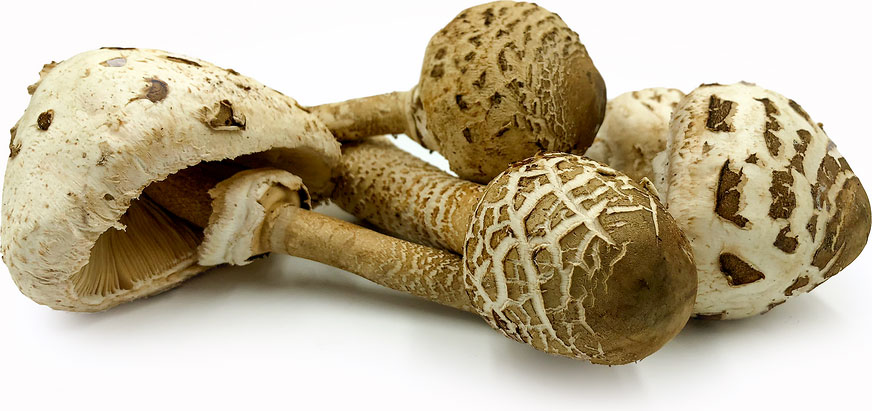
Parasol
(aka Snake’s Hat, Snake’s Sponge)
Parasol mushrooms are medium to large in size with caps and stems that can reach up to 40 centimeters in height and diameter. When young, the pale brown caps are egg-shaped and rounded with a small dark brown nob at the top. As they mature, they open into an umbrella shape, eventually flattening out, and the dark brown nob breaks into flaky scales. The average Parasol cap ranges from 10 to 25 centimeters in diameter and has white, soft, and slightly spongy flesh when sliced. Underneath the cap, there are free, crowded, white gills, and the ivory-colored stem is fibrous with a snakeskin-like pattern of dark brown flakes. There is also a partial veil that breaks and becomes a movable ring on the stem as the mushroom matures. When cooked, Parasol mushrooms are tender and are known for their rich umami flavor and nutty, sweet aroma that some say smells like maple syrup. This flavor becomes more intense as the mushroom ages and more pungent if the mushroom is dried.
Parasol mushrooms contain vitamin D, iron, zinc, copper, selenium, fiber, amino acids, and also contain some antioxidant and antimicrobial properties.
Parasol
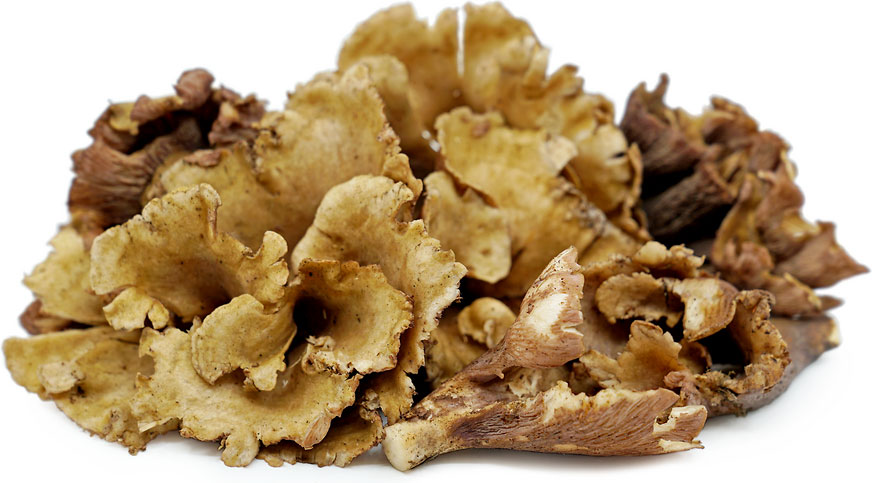
Pig’s Ear
(aka Violet Chanterelle)
Pig’s Ear mushrooms are small to medium in size, averaging 5 to 15 centimeters in diameter, and are comprised of many folds, layers, and ridges. The caps are funnel or flute shaped and are recognized by their purple sides and their depressed yellow-brown center when young. As the mushroom ages, it will fade into a dull tan. The cap’s edges are wavy and smooth, and instead of true gills, there are many false gills in the form of ridges and shallow veins running on the sides of the cap. When sliced, the flesh of the mushroom is white and solid. Pig’s Ear mushrooms are firm and dense with a musty, earthy flavor and aroma.
Pig’s Ear mushrooms contain iron, zinc, copper, vitamin D, fiber, and fatty acids that have antifungal properties. They also contain several essential enzymes such as protease, amylase, and lipase, which aid in the digestion of proteins, starches, and fats.
Pig’s Ear
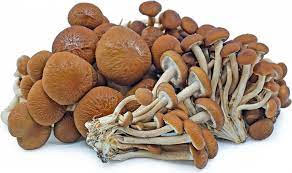
Pioppino
(aka Black Poplar, Velvet Pioppino)
Pioppini mushrooms are small to medium in size with convex to flattened caps connecting to thin, elongated stems. The firm, soft, and silky caps average 3 to 10 centimeters in diameter and range in color from dark brown to light brown-grey, growing darker towards the center. Underneath the cap, there are small, grey-brown gills containing dark spores, and the gills connect to the fibrous cream-colored stem that has a texture similar to asparagus. When cooked, Pioppini mushrooms have a faint floral aroma and are meaty and crunchy with a nutty, slightly sweet, peppery, and earthy flavor.
Pioppini mushrooms are rich in copper, fiber, and vitamin B5 and also contain potassium, biotin, folate, iron, selenium, and vitamins B2 and B3. Additionally, they have antifungal and antibiotic properties.
Pioppino
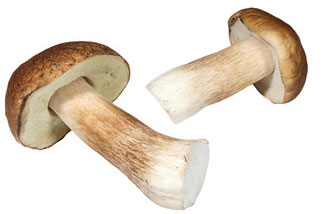
Porcini
(aka King Bolete, Cap, Cepe de Bordeaux)
Porcini mushrooms are small to large in size with a very thick stem and a rounded cap that averages 7 to 30 centimeters in diameter. The red-brown to dark brown caps are smooth, slightly sticky, and are convex when young, flattening out with age. Underneath the cap, there are many ivory, spongy tubes which release green-brown spores to propagate. The cream-colored stems average 8 to 25 centimeters in height and are broad, wide, firm, and dense with small ridges on the bottom portion of the stem. The flesh is white and solid when sliced and emits a yeasty aroma reminiscent of sourdough. When cooked, Porcini mushrooms are creamy, tender, and smooth with a nutty, earthy flavor.
Porcini mushrooms contain iron, fiber, vitamins C and A, and are high in antioxidants.
Porcini
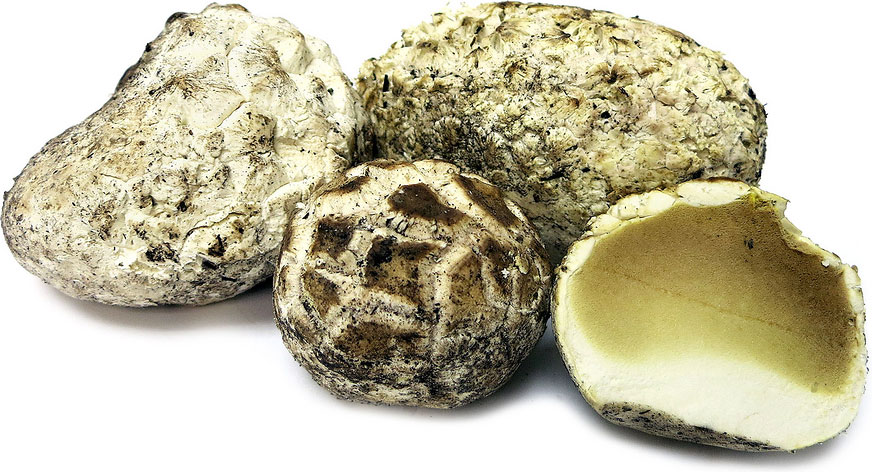
Puffball
(aka Breakfast)
Puffball mushroom is a general term used to describe 32 species that are members of the Basidiomycetes family. The common Calvatia gigantia roughly translates to “giant bald head” and is often referred to as a Giant Puffball. Puffball mushrooms range from small to very large in size, averaging 10 to 70 centimeters in diameter, and are round, oblong, to oval in shape. Some species are small, golf-ball sized, while others can grow as large as soccer balls. The white fruiting body can be smooth or bear some small scales, warts, or spines and is firm, airy, and spongy. There is also a protective coating that helps keep debris and dirt from entering the flesh. When sliced, the flesh should be pure white and never have any color. Puffball mushrooms are white when young and transition to a yellow-brown when mature and are rendered inedible when they reach this state. There are little to non-existent stems, and the spores are produced internally in the fruiting body. When young, Puffball mushrooms have a mild, nutty, and earthy flavor.
Puffball mushrooms have some phosphorus, manganese, selenium, and clavacin.
Puffball
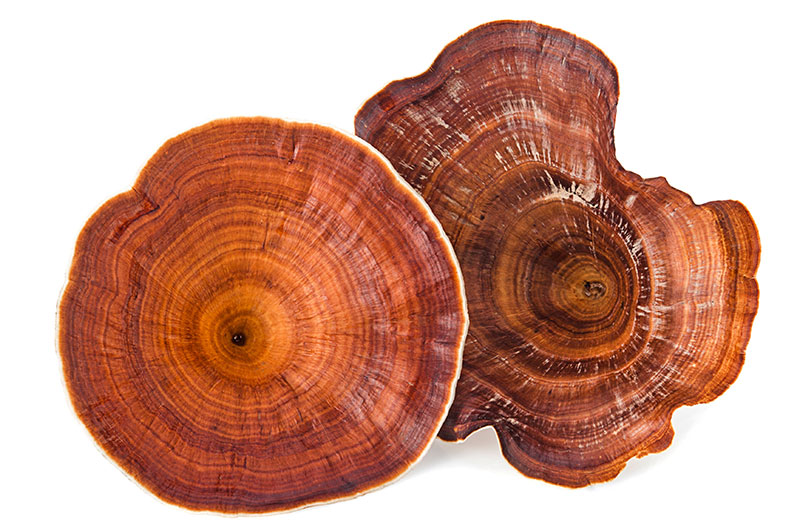
Reishi
(aka Lingzhi)
The Reishi mushroom has a long history of use for promoting health and longevity in China, Japan, and other Asian countries. It is a large, dark mushroom with a glossy exterior and a woody texture. The Latin word lucidus means “shiny” or “brilliant” and refers to the varnished appearance of the surface of the mushroom. In China the mushroom is called lingzhi, whereas in Japan the name for this family is Reishi or Mannentake.
In China the Reishi mushroom is regarded as the “herb of spiritual potency,” symbolizing success, well-being, divine power, and longevity. Among cultivated mushrooms it is unique in that its pharmaceutical rather than nutritional value is paramount. The specific applications and attributed health benefits of Reishi include control of blood glucose levels, modulation of the immune system, hepatoprotection, bacteriostasis, and more. Polysaccharides, peptidoglycans, and triterpenes are three major physiologically active constituents in G. lucidum.
Reishi
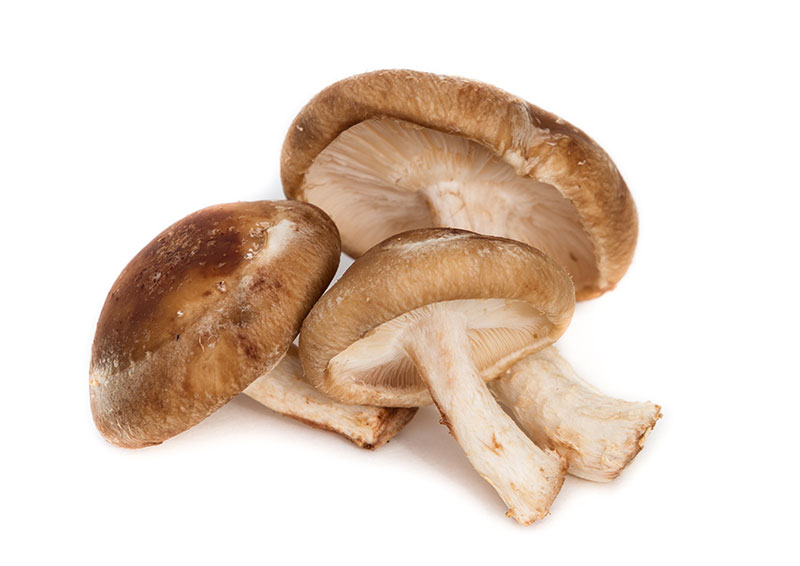
Shiitake
(aka Black Forest, Black Winter, Brown Oak, Chinese Black)
The second most commonly consumed mushroom in the world, this species has a light woodsy flavor and aroma, while their dried counterparts are more intense. When cooked, Shiitakes release a garlic-pine aroma and have a savory, earthy, and smoky umami flavor with a chewy, dense texture. Shiitake mushrooms are small to medium in size with caps averaging 10 to 20 centimeters in diameter and are attached to thin stems. The caps range in color from light to dark brown and have a wide, umbrella shape with a characteristic curled rim. Inside, the cream-colored flesh is firm, chewy, and spongy. Underneath the cap, the white gills are tightly arranged, are not attached to the stem, and depending on the maturity, there may also be a thin veil covering the gills. The ivory to light brown stem is smooth, tough, and fibrous.
Shiitake mushrooms contain vitamins A, B2, B12, C, and D, iron, calcium, copper, selenium, zinc, and manganese.
Shiitake
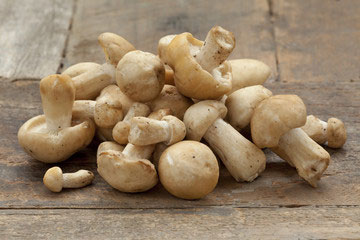
St. George
St. George mushrooms are small to medium in size with caps averaging 5 to 15 centimeters in diameter and are connected to thick, stout stems. The smooth, ivory, umbrella-shaped caps are firm with inwardly curled edges. The caps may also become irregular in shape with tan or sunblushed spots from age and exposure to the sun. Underneath the cap, there are many white gills that are very narrow and crowded. The white, broad, club-footed stem averages 2 to 7 centimeters in length and may be straight or slightly curved. St. George mushrooms have an unusual cucumber and mealy, flour aroma and are somewhat powdery with an earthy flavor.
St. George mushrooms contain vitamin D, dietary fiber, calcium, iron, and some vitamin C.
St. George
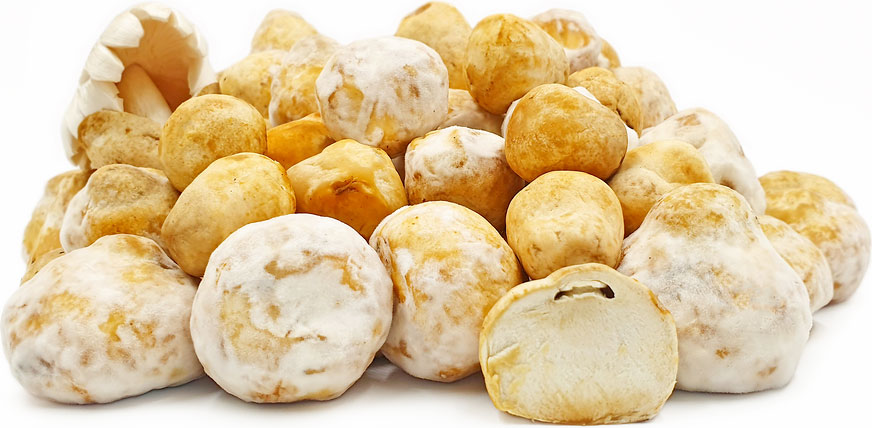
Straw
(aka Paddy Straw)
Straw mushrooms grow in clusters and have varying appearances depending on maturity. When young, the cap is encased in a thin skin, and the stalk is short, creating an oval, egg-like shape. The top of the cap is generally dark brown, lightening to a cream-colored hue around the edges and on the stem. As the mushroom matures, the stem lengthens from 4 to 14 centimeters, and the protective skin is separated from the cap, allowing the cap to expand and widen. The cap then transforms into a convex, broad shape, sometimes almost appearing flat, and averages 5 to 12 centimeters in diameter. The once dark brown cap also lightens to a grey or shade of light brown. Underneath the cap, the crowded gills range in color from white to pink depending on maturity and are not attached to the stem. Straw mushrooms have a smooth, velvety, and tender texture with a mild, earthy, and musky flavor.
Straw mushrooms are an excellent source of copper, which provides antibacterial properties, and potassium, which can help regulate fluids and maintain optimal blood vessel functioning. The fungi also contain vitamins B, C, and D, fiber, zinc, iron, and amino acids. In traditional Chinese medicine, Straw mushrooms are believed to help clean and thin the blood while also removing heat from the body.
Straw
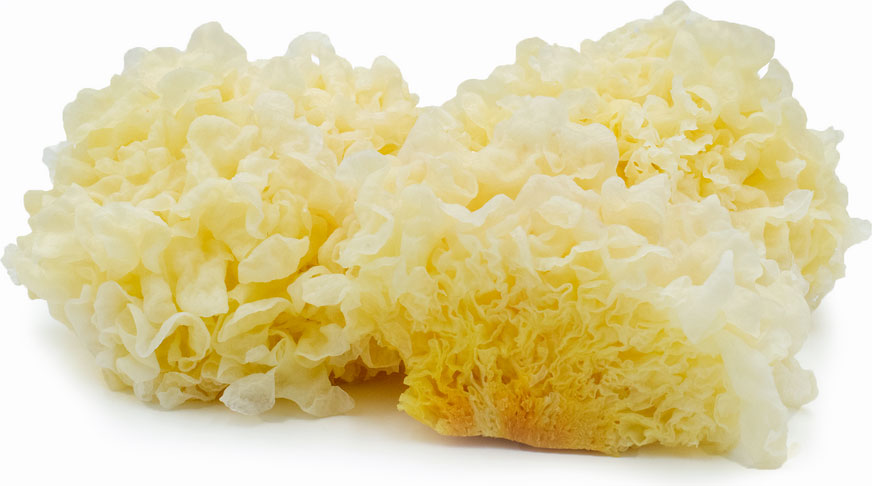
Tremella
Tremella mushrooms are small to medium in size, averaging 5 to 7 centimeters in diameter, and are thin, ruffled, and made up of branching fronds that are attached to a central base. The fruiting body is white, pale yellow, or tan and is semi-translucent with a smooth, shiny, and gelatinous texture. When young, the mushroom is soft and moist and with age, they begin to shrink and become leathery. Tremella mushrooms have a spicy odor that dissipates with cooking and are chewy and supple with a very mild flavor.
These mushrooms are an excellent source of fiber and vitamin D and also contain antioxidants, vitamins B1, B2, and B6, folate, zinc, potassium, calcium, magnesium, iron, and copper.
Tremella
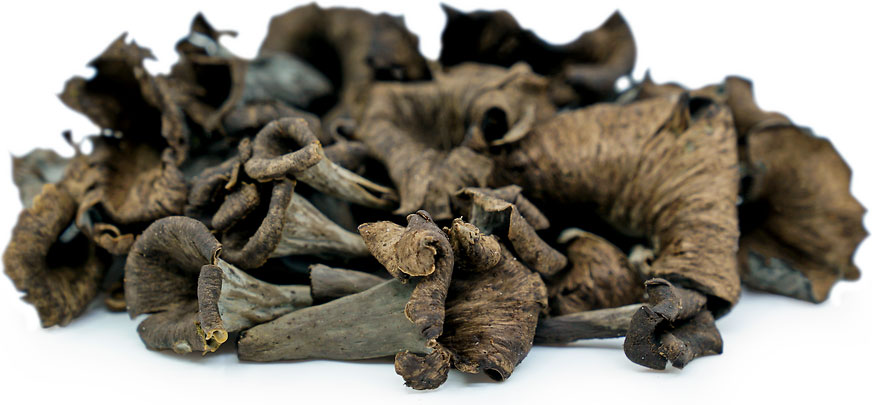
Trumpet, Black
(aka French Horn, Black Chanterelle)
Black Trumpet mushrooms are small in size, averaging 2 to 15 centimeters in height, and have a delicate funnel or vase shape with a cap that has outwardly curled and wavy edges. Growing in small bunches or sometimes found individually, Black Trumpet mushrooms range in color from brown, black, to grey and are identifiable by the lack of gills on the underside of the cap. The skin is thin, smooth, and slightly wrinkled with a suede-like feel. Inside the cap, there may be some small scales present, and the stem is also hollow and fragile. Black Trumpet mushrooms have a strong sweet, woodsy aroma and have a soft, yet chewy texture with a rich, nutty, and smoky taste.
Black Trumpet mushrooms are high in vitamin B12, which helps maintain normal brain and nervous system functions, and contain some antioxidants.
Trumpet, Black
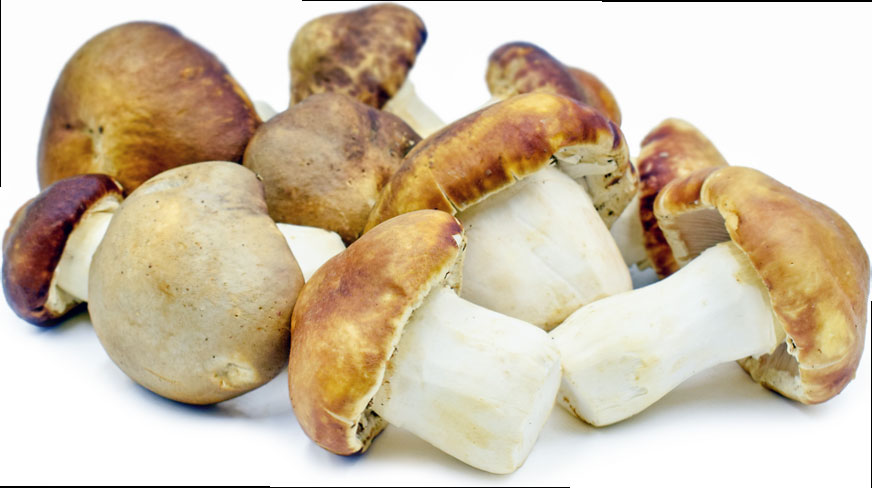
Wine Cap
(aka Garden Giant, Burgundy, King Strophana)
Wine Cap mushrooms are medium to large in size with caps averaging 6 to 13 centimeters in diameter and are attached to long, thick stems. When young, the burgundy, red-brown caps emerge rounded, folded over, and slightly sticky. As the mushroom matures, the smooth cap detaches from the stem, flattens out, and becomes dry and cracked and transitions to a yellow-brown. Underneath the cap, the attached, crowded gills begin pale and become grey to purple, and a partial veil covers the gills when young, breaking when mature and leaving a wrinkled ring or annulus around the stem. The white, broad stems can reach up to 20 centimeters in length, and the flesh is also white when sliced and firm. When cooked, Wine Cap mushrooms are crisp with a mild, earthy, and nutty flavor with hints of potatoes and red wine.
Wine Cap mushrooms contain fiber, vitamin D, amino acids, protein, iron, copper, and some calcium.
Wine Cap
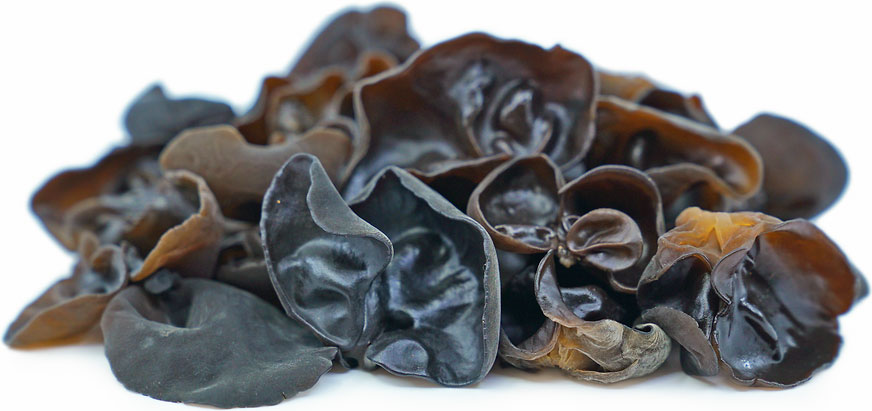
Wood Ear
(aka Tree Ear, Black Fungus, Jelly Ear)
Wood Ear mushrooms are small to medium in size, averaging 3 to 8 centimeters in diameter, and are curved and wavy with an ear-like or cup-like shape. The fruiting bodies are brown to dark brown with a slippery or gelatinous texture and can be made up of smooth, wavy edges or many folds and wrinkles with some veining. With age, the gill-less and stemless fungus darkens, and the spores range in color from yellow, cream, to white. When cooked, Wood Ear mushrooms are firm, crunchy, and tasty with a mild, musty flavor.
Wood Ear mushrooms contain iron, protein, fiber, and vitamins B1 and B2.
Wood Ear
FRUITS
HERBS
VEGETABLES



